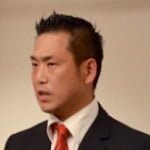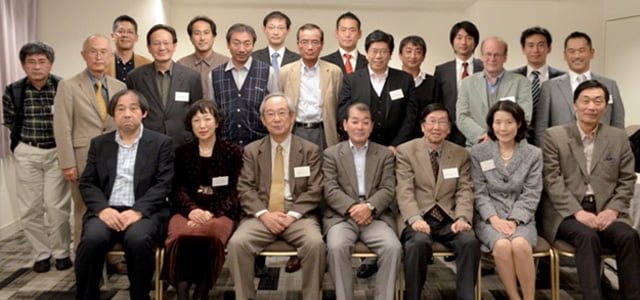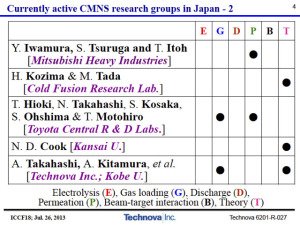Photo: Participants of the 15th meeting of Japan CF-Research Society courtesy Clean Planet, Inc.

This year’s event was co-hosted by Hideki Yoshino, Founder of Clean Planet, Inc, a company providing resources to the LENR research community there, and Dr. Tadahiko Mizuno, scientist with Hydrogen Engineering Application & Developing Company and author, Nuclear Transmutation: The Reality of Cold Fusion. [buy].
Members from academia, business, government policy makers and industry in Japan were present. Dr. Akira Kitamura, an experimentalist associated with Technova, Inc and Kobe University, listed about ten active cold fusion research projects active in the country during his presentation in 2013 at ICCF-18 in The Way Forward panel [watch]. It was representatives from these groups who reported at the JCF-15 conference.
Slides from Akira Kitamura in The Way Forward Panel presented at ICCF-18.
The program alternated between sessions on experiment and sessions on theory.
Co-organizer Hideki Yoshino said, “Emeritus Professor Takahashi from Osaka Univerisity presented his theories based on the results of Professor Kitamura and Dr. Iwamura from Mitsubishi Heavy Industries. These parities demonstrated the spirit of cooperation needed and the importance of collaboration by delivering tangible results.”
Yoshino described the “passionate” atmosphere of collaboration, and hints at a possible set of benchmarks to be delivered:
“Due to the relatively remoteness of Saporo, the conference attracted passionate and committed individuals from their respective fields to contribute in a manner which at times became very intense. This passion and intensity translated to the exchanges, which raised the bar for all those who attended to deliver on goals which otherwise wouldn’t have been set. These exchanges not only raised the bar on measurable and deliverable targets but also made each individual accountable to the collective group.”
“The attendance of Emeritus Professor Kasagi from Tohoku University further demonstrated the quality of the the attendees. He aggressively challenged each one of the presenters on their respective theories and the results of their experiments. His strong demeanor insured the validity and accountability of factual information of theories and processes.”
Proceedings from the meeting have not yet been released, however previously published papers describe some of the research tracks.
 Experimentalist Tadahiko Mizuno of Hydrogen Engineering A&D Co. gave the Opening Address and presented Analysis of Heat Generation using Pd and Ni Fine Wires. Recently, archivist Jed Rothwell of lenr.og spent time with Dr. Mizuno and produced Report on Mizuno’s adiabatic calorimetry [.pdf].
Experimentalist Tadahiko Mizuno of Hydrogen Engineering A&D Co. gave the Opening Address and presented Analysis of Heat Generation using Pd and Ni Fine Wires. Recently, archivist Jed Rothwell of lenr.og spent time with Dr. Mizuno and produced Report on Mizuno’s adiabatic calorimetry [.pdf].
Theorist Akito Takahashi of Technova Inc. presented Background for Condensed Cluster Fusion. Dr. Takahashi’s Physics of Cold Fusion by TSC Theory was also published in JSCMNS Vol 13. [DOWNLOAD and go to Acrobat page 575]
Yasuhiro Iwamura et al. of Mitsubishi Heavy Industries presented Increase of Transmutation Products by Electrochemical Deuterium Permeation through Nano-Structured Pd Multilayer Thin Film. A paper on this research program Increase of Reaction Products in Deuterium Permeation-induced Transmutation by Iwamura, Y., T. Itoh, and S. Tsuruga, can be found in the Journal of Condensed Matter Nuclear Science Vol. 13 published May 2014. [DOWNLOAD and go to Acrobat page 252]
Theorist Ken-ichi Tsuchiya of the National Institute of Technology, Tokyo College spoke on Convergence Aspect of the Self-consistent Calculations for Quantum States of Charged Bose Particles in Solids. Quantum States of Charged Bose Particles in Solids from JCF-5 describes the groundwork.[.pdf] See also, JCMNS Vol. 13 published A Self-Consistent Iterative Calculation for the Two Species of Charged Bosons Related to the Nuclear Reactions in Solids [DOWNLOAD and go to Acrobat page 604]
Akira Kitamura et al. of both Technova Inc. and Kobe University presented Comparison of some Ni-based nano-composite samples with respect to excess heat evolution under exposure to hydrogen isotope gas at the meeting. JSCMNS Vol 13 published Recent Progress in Gas-phase Hydrogen Isotope Absorption/Adsorption Experiments by A. Kitamura, Y. Miyoshi, H. Sakoh, A. Taniike, Y. Furuyama, A. Takahashi, R. Seto, Y. Fujita, T. Murota and T. Tahara. [DOWNLOAD and go to Acrobat page 287]
Says Yoshino, “This ongoing cooperation and collaboration among the members of JCF towards a single vision of creating clean, abundant and safe energy for all mankind, is essential for the realization of our collective goal.”
Find more photos of JCF-15 on the Clean Planet Gallery.
Related Links
Nuclear Transmutation: The Reality of Cold Fusion by Dr. Tadahiko Mizuno





Thanks for the report
With my 15 years experience with orgone energy devices, static electric charge and interposing waves I need to rub elbows with someone that knows what the f— I’m talking about.
Brent
If you like to know that the Colomb barrier can be surmounted by “Coulomb Explosion” have a look at the article “LANR by Coulomb Explosion” published on the former blogsite; “e-Cat Site” no longer on the web, but available through “Cold Fusion Now” Belgian patents BE1002780, BE1002781 and BE1003296 translated into English in said article. Coulomb explosion in liquid lithium may proceed in the BLASCON reactor of Fraas (US patent) operating however with laser-exposure of fusion matrial in frozen pellets.
From the Lugano report about the Rossi experiment it is clear that the heating to start the reaction comes from an electric resistor wire(s) . Why not devide the Rossi fuel into small solid pellets and expose the to laserlight for heating them. As e.g. in the BLASCO reactor of Fraas (US patent) using liquid lithium as receptor and notice the heating of the lithium for use in a heat convertor. Have a check on radioactivity or helium production.
The BLASCON reactor of Fraas has been patented in US-P 3,624,239. Have a look and take your conclusions.